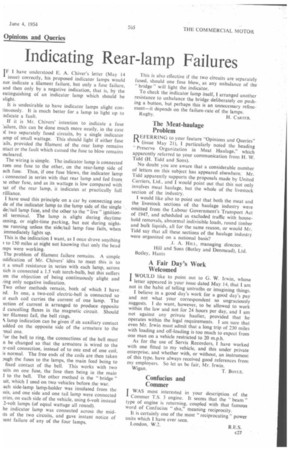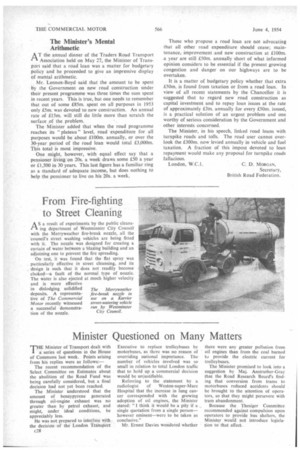Indicating Rear-lamp Failures
Page 65

Page 66

If you've noticed an error in this article please click here to report it so we can fix it.
FF I have understood E. A. Chiver's letter (May 14 L issue) correctly, his proposed indicator lamps would lot indicate a filament failure, but only a fuse failure, ind then only by a negative indication, that is, by the !xtinguishing of an indicator lamp which should be 'light.
It is undesirable to have indicator lamps alight coninitously. It is much better for a lamp to light up to ndicate a fault.
If it is Mr. Chivers' intention to indicate a fuse 'ailure, this can be done much more neatly, in the case A two separately fused circuits, by a single indicator amp of small wattage. This should light if either fuse ails, provided the filament of the rear lamp remains ntact or the fault which caused the fuse to blow remains incleared.
The wiring is simple. The indicator lamp is connected rom one fuse to the other, on the rear-lamp side of ach fuse. Thus, if one fuse blows, the indicator lamp ; connected in series with that rear lamp and fed from le other fuse, and as its wattage is low compared with tat of the rear lamp, it indicates at practically full rilliance.
I have used this principle on a car by connecting one de of the indicator lamp to the lamp side of the single dc/tail lamp fuse, and the other to the " live " ignitionAl terminal. The lamp is alight during daytime inning, or night-time parking, but not during nightTie running unless the side/tail lamp fuse fails, when immediately lights up.
This is the indication 1 want, as I once drove anything to 150 miles at night not knowing that only the head nips were working.
The problem of filament failure remains. A simple odification of Mr. Chivers' idea to meet this is to it a small resistance in series with each lamp, across lich is connected a 1.5 volt torch-bulb, but this suffers tin the objection of being continuously alight and ring only negative indication.
Two other methods remain, both of which I have Dd. In one, a two-coil electric-bell is connected so it each coil carries the current of one lamp. The ection of current is arranged to produce opposite 1 cancelling fluxes in the magnetic circuit. Should ler filament fail, the bell rings.
%. lamp indication can be given if an auxiliary contact added on the opposite side of the armature to the -mal one.
or the bell to ring, the connections of the bell must n be changed so that the armature is wired to the :r-coil connection, instead of to onc end of one coil, is normal. The free ends of the coils are then taken 3ugh the fuses to the lamps, the main feed being to fixed contact of the bell. This works with two 'uits on one fuse, the fuse then being in the main 1 to the bell. The other method is the " bridge " uit, which I used on two vehicles before the war. ach side-lamp lamp,-holder was insulated from the ssis, and one side and one tail lamp were connected Dries, on each side of the vehicle, using 6-volt instead 2-volt lamps (of equal wattage all round).
he indicator lamp was connected across the midits of the two circuits, and gave instant notice of lent failure of any of the four lamps. This is also effective if the two circuits are separately fused, should one fuse blow, as any unbalance of the " bridge " will light the indicator.
To check the indicator lamp itself, I arranged another resistance to unbalance the bridge deliberately on pushing a button, but perhaps this is an unnecessary refinement—it depends on the failure-rate of the lamps.
Rugby. H. CARTER.
The Meat-haulage Problem
REFERRING to your feature "Opinions and Queries" (issue May 21), I particularly noted the heading "Preserve Organization in Meat Haulage," which apparently referred to your communication from H. W. Tidd (H. Tidd and Sons).
No doubt you are aware that a considerable number of letters on this subject has appeared elsewhere. Mr. Tidd apparently supports the proposals made by United Carriers, Ltd., and I would point out that this not only involves meat haulage, but the whole of the livestock section of the industry.
I would like also to point out that both the meat and the livestock sections of the haulage industry were omitted from the Labour Government's Transport Act of 1947, and scheduled as excluded traffic with household removals, abnormal indivisible loads, round timber and bulk liquids, all for the same reason, or would Mr. Tidd say that all these sections of the haulage industry were organized on a national basis?
J. A. Hui, managing director.
Hill and Sons (Botley and Denmead), Ltd. Botley, Hants
A Fair Day's Work Welcomed
I WOULD like to point out to G. W. Irwin, whose 1 letter appeared in your issue dated May. 14, that I am not in the habit of telling untruths or imagining things.
I believe in a good day's work for a good day's pay and not what your correspondent so ungraciously suggests. I do want, however, to be allowed to work within the law and not for 24 hours per day, and I am not against any private haulier, provided that he operates within the legal requirements. I am sure that even Mr. Irwin must admit that a long trip of 230 miles with loading and off-loading is too much to expect from one man on a vehicle restricted to 20 m.p.h.
As for the use of Servis Recorders, I have worked with one fitted to my vehicle, and this under private enterprise, and whether with, or without, an instrument of this type, have always received good references from my employers. So let us be fair, Mr. Irwin.
Wigan. T. BOYLE.
Confucius and Commer
I WAS most interested in your description of the I Commer T.S. 3 engine. It seems that the " beam" type of engine is returning, coupled with that famous word of Confucius " shu," meaning reciprocity.
The Minister's Mental Arithmetic
A T the annual dinner of the Traders Road Transport 1-1 Association held on May 27, the Minister of Transport said that a road loan was a matter for budgetary policy and he proceeded to give an impressive display of mental arithmetic.
Mr. Lennox-Boyd said that the amount to be spent by the Government on new road construction under their present programme was three times the sum spent in recent years. This is true, but one needs to remember that out of some £85m. spent on all purposes in 1953 only £5m was devoted to new construction. An annual rate of £15m. will still do little more than scratch the surface of the problem.
The Minister added that when the road programme reaches its " plateau " level, road expenditure for all purposes would be about £100m. annually, or over the 30-year period of the road loan would total £3,000m. This total is most impressive.
One might, however, with equal effect say that a pensioner living on 20s. a week draws some £50 a year or £1,500 in 30 years. This last figure has a familiar ring as a standard of adequate income, but does nothing to help the pensioner to live on his 20s. a week. Those who propose a road loan are not advocating that all other road expenditure should cease; maintenance, improvement and new construction at £100m. .a year are still £50m. annually short of what informed opinion considers to be essential if the present growing congestion and danger on our highways are to be overtaken.
It is a matter of budgetary policy whether that extra £50m. is found from taxation or from a road loan. In view of all recent statements by the Chancellor it is suggested that to regard new road construction as capital investment and to repay loan issues at the rate of approximately £3m. annually for every £50m. issued, is a practical solution of an urgent problem and one worthy of serious consideration by the Government and other interests concerned.
The Minister, in his speech, linked road loans with turnpike roads and tolls. The road user cannot overlook the £300m. now levied annually in vehicle and fuel taxation. A fraction of this impost devoted to loan repayment would make any proposal for turnpike roads fallacious.
London, W.C.1. C. D. MORGAN,
Secretary, British Road Federation.












































































































